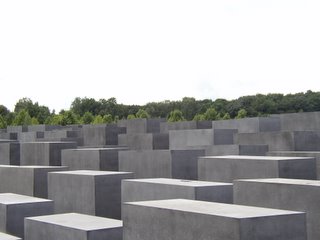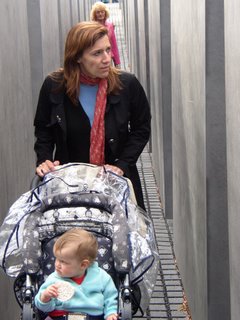The Rights of Neo-Nazis

The new Holocaust Memorial in Berlin is not only aesthetically path-breaking but challenges our very notions of what a memorial should be and how it should function.
The memorial is a sprawling collection of stone blocks. There is no front, back, or side. There is no entrance and no definitive, monumental perspective. It looks different from every angle, and the experience is particularly different once you "enter" and start walking among the pillars. No plaque introduces the monument or tells you what it all means. The visitors' center is underneath the memorial, and you almost have to know it's there in order to find it.
Unlike almost every other "Jewish" or Holocaust-related site in Germany, there are no policemen around to protect it or to insure that visitors are solemn and respectful. Soon after opening last spring, the Memorial became a popular meeting point for tourists, friends, lovers, etc. I've seen couples making out, children playing tag, teenagers hopping from one pillar to another (the latter is technically forbidden).
This has upset a lot of people. They ask: Doesn't a memorial to the murder of 6 million Jews right here, at the heart of the decision-making center, need to carry a certain sacred aura? Given the need to remind people of the genocide, shouldn't we take steps to insure that they appreciate the substantive truths behind the symbolic forms in front of them?
The American designer of the memorial, Peter Eisenmann, basically says no. He is asking us to think differently about memorialization, to see it as an open-ended, indeterminate process. Each visitor will relate to the memorial in his or her own way. Over time, this relationship will hopefully deepen. The reality of the Holocaust will have a presence in their lives, whether they're conscious of it or not.
All, very interesting. But what do you do when a group of neo-Nazis (as happened last spring) want to march by the memorial with banners declaring "60 years of Lies about 'Liberation' -- Away with the Cult of Guilt!"?

An interesting article in a recent issue of Merkur discusses this case. The state court in Berlin ruled that members of the right-wing political party, the NPD, were not allowed to march by the memorial, even if they were silent and even if their banners were rolled up. The court argued that the party's slogans presented National Socialism as a "harmless" affair and compromised the "dignity of the victims."
The author of the piece, Horst Meier, argues against the court's decision in terms that will sound very familiar to an American audience. He draws upon John Stuart Mill and other classic civil libertarians to argue that this is an issue of pure speech, since the demonstrators were clearly not threatening public order or security. The Nazi experience, Meier argues, should have taught Germans that "a pluralistic society cannot allow a real or imagined majority to impose upon others their idea of the common good or of 'good morals.'"
I wonder Eisenmann makes of all this.


0 Comments:
Post a Comment
Subscribe to Post Comments [Atom]
<< Home